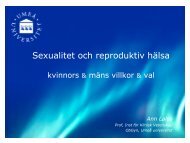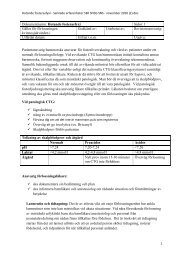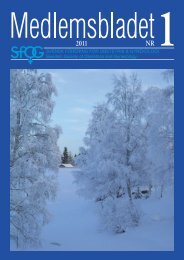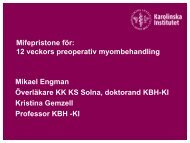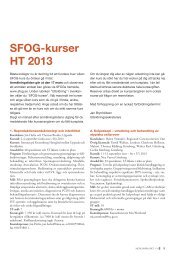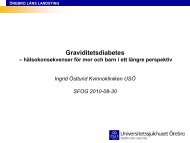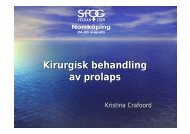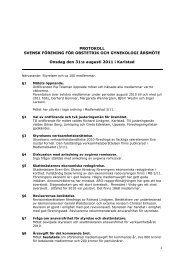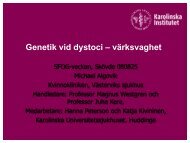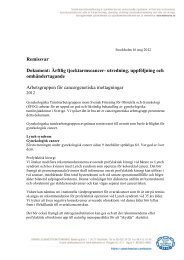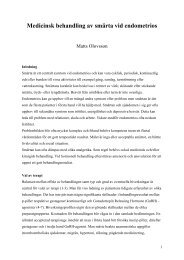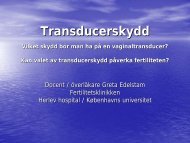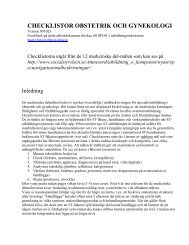Medlemsblad 4 2005 - SFOG
Medlemsblad 4 2005 - SFOG
Medlemsblad 4 2005 - SFOG
Create successful ePaper yourself
Turn your PDF publications into a flip-book with our unique Google optimized e-Paper software.
Ny avhandling<br />
The Climacteric<br />
Management and Attitudes among Women and Physicians<br />
Aims: Paper I: To longitudinally assess the<br />
prevalence of climacteric symptoms, the<br />
use of hormone replacement therapy<br />
(HRT) and life-style factors in the same<br />
women in 1992 (aged 46-62 years) and in<br />
1998 (aged 52-68 years). Paper II: To<br />
study changes in (i) the prevalence of HRT<br />
use and (ii) attitudes and knowledge about<br />
the climacteric among 46-62 years old<br />
women resident in Göteborg 1992 and<br />
1998. Paper III: To study changes in<br />
management strategies concerning HRT<br />
among gynecologists in Sweden and to<br />
assess possible use of HRT among gynecologists.<br />
Paper IV: To investigate the effect<br />
on glucose homeostasis and plasma lipids<br />
of treatment with estradiol and norethisterone<br />
acetate (NETA) in postmenopausal<br />
women with type 2 diabetes.<br />
Patients and methods: Papers I & II:<br />
Population-based studies initiated in 1992<br />
in 46-62 years old women, (5 birth cohorts)<br />
randomly obtained from the population<br />
register. The women received a postal questionnaire<br />
regarding life-style, the climacteric<br />
and its treatment. Paper I: In a prospective,<br />
longitudinal cohort study the<br />
same women (n = 3816) were assessed<br />
again in 1998 with a similar questionnaire.<br />
Paper II: In a new cross-sectional study<br />
1998, with identical design as the study<br />
from 1992, a random sample of 5411<br />
women of the same ages as in the study<br />
from 1992 was contacted. Paper III: In<br />
1996, gynecologists in Sweden (n = 1323)<br />
were invited to return a postal questionnaire<br />
about (i) their attitudes, knowledge<br />
and management strategies concerning<br />
HRT and (ii) their own or their partners<br />
possible use of HRT. In 2003, the same<br />
technique was used and a similar questionnaire<br />
was sent to practicing gynecologists<br />
in Sweden (n = 1320). Paper IV:<br />
Thirty-one postmenopausal women with<br />
type 2 diabetes were included in a randomised,<br />
double-blind, placebo-controlled<br />
Louise Thunell, MD, Department<br />
of Obstetrics and Gynecology<br />
Sahlgrenska Academy at Göteborg<br />
University, Göteborg, Sweden<br />
study with cross-over design. Each treatment<br />
period was 6 months. All metabolic<br />
and anthropometric examinations were<br />
performed at baseline and after each treatment<br />
period.<br />
Results: Paper I: The prevalence of<br />
climacteric symptoms increased in the<br />
same women between 1992 and 1998:<br />
vasomotor symptoms 52%/62%, sleep<br />
disturbances 51%/69%, loss of libido<br />
38%/57%, depression/irritability 57%/<br />
65%. Current use of HRT increased from<br />
14% in 1992 to 34% in 1998. The number<br />
of smokers decreased (32% to 26%)<br />
and BMI and exercise increased. Paper II:<br />
HRT use increased between 1992 (13%)<br />
and 1998 (31%) in the cross-sectional<br />
comparison. The highest prevalence was<br />
reported in women 54 years of age (46%).<br />
Forty-four percent of the women were prepared<br />
to consider life-long HRT if the treatment<br />
was free from withdrawal bleedings<br />
(35%, 1992). Eighty percent believed<br />
that the risk of osteoporosis decreased<br />
during HRT use (61%, 1992) and 68%<br />
thought that the risk of breast cancer increased<br />
(58%, 1992). Paper III: In 2003,<br />
11% of the gynecologists thought that all<br />
women without contraindications should<br />
be offered HRT compared to 44% in 1996.<br />
Twenty-five percent in 2003 stated that<br />
risk factors for osteoporosis were absolute<br />
indications for HRT compared to 60% in<br />
1996. Current ischaemic heart disease was<br />
considered to be an indication for HRT<br />
by 7% in 2003 (60% in 1996). Seventyone<br />
per cent of female gynecologists and<br />
68% of the male gynecologists´ partners<br />
used HRT in 2003 (88 och 86% in 1996).<br />
Paper IV: Estradiol/NETA therapy decreased<br />
hyperandrogenicity i.e. sex hormone<br />
binding globulin (SHBG) increased and<br />
free testosterone decreased. Lipoprotein<br />
(a) and plasminogen activator inhibitor-<br />
1 (PAI-1) decreased. No changes in glucose<br />
homeostasis were found.<br />
Conclusions: Symptoms associated with<br />
the climacteric period increased in the<br />
same birth cohorts of women from 46-62<br />
to 52-68 years of age. Use of HRT increased<br />
markedly between 1992 and 1998 in<br />
women in Göteborg, Sweden.<br />
Gynecologists in Sweden were more cautious<br />
in their management strategies concerning<br />
HRT in 2003 compared to 1996<br />
and their personal use of HRT had also<br />
decreased. The impact on cardiovascular<br />
risk factors and glucose homeostasis of 2<br />
mg estradiol/1 mg NETA in postmenopausal<br />
women with type 2 diabetes is probably<br />
neutral.<br />
Keywords: climacteric, epidemiology, longitudinal,<br />
climacteric symptoms, hormone<br />
replacement therapy, attitudes, knowledge,<br />
gynecologists, postmenopausal, type 2 diabetes,<br />
hyperandrogenicity, glucose homeostasis,<br />
lipids, PAI-1<br />
MEDLEMSBLADET 4/ 05 53



